The Nirvana Trade July 24, 2013
Doug
Wakefield
“What
the mind can conceive and believe it can achieve” Napoleon Hill
When
one looks at the US stock markets over the last two years, especially since August
2011, it would appear that it has become liberated from entering a bear market
for more than a few days or weeks.
With
each subsequent drop, a rally has ensued. US stock indices seem to move one
step closer to nirvana with each passing “minor correction” in prices. One need
never worry again, as we gain greater confidence in the masters of finance, who
with the mere mention of the words, “a highly accommodative policy”, can
levitate stocks.
But
something is very wrong with this picture.
Outside of the Dow’s value scrolling across the bottom of the daily news
or the values showing up in our monthly online statement, is the every
increasing dependency on more and more debt and “temporary” intervention to
make certain “the recovery” removes all memory of the events of 2008 from our
minds. Outside of the euphoric, “all time highs achieved again” is the nagging
reality that no negative geopolitical or global economic event or data has
phased US stocks for almost 2 years now. A bad day or two for sure, but that is
all that the public has had to experience for almost 22 months.
Have
we really arrived at a world of no pain and all gains, brought to us by the
“highly accommodative policies” of the masters of finance and market
intervention?
As
we head into August, I would like to present you with data I believe supports
the reality that millions of investors are soon to be stunned once again like
they were in 2008. Like the Tsunamis we have watched in the last 10 years, we
must remind ourselves and others that the bursting of global stock bubbles
don’t care about our long term plans, they change the landscape for everyone,
including central bankers.
Lessons 1 – Forget The Real World, Watch the Computer. Power Continues to Concentrate
For
months and months, anyone trying to explain why major technical, fundamental,
or geopolitical risk would impact US stocks has looked like a fool who did not
understand the new paradigm, brought to you by your nearest central banker.
Sadly, this has bred rising complacency along with rising stock prices. Yet
while this rally has gone on much longer than I and many others would have
imagined, anyone willing to examine the evidence through what has ALREADY
occurred, can see that the nirvana rally moves closer each day to a painful
return to reality.
If
you have no understanding of high frequency trading platforms or speed computer
trading, then watch the report released by 60 minutes in June 2011, Wall Street: The Speed
Traders. Anyone who believes this film is solely for those interested in
keeping up with “financial news”, needs to remember that in July 2011, the Dow
topped and lost 2100 points (16.8%) in 13 trading days.
Consider
the following opening remarks from this excellent piece:
“Most
people don't know it, but the majority of the stock trades in the United States
are no longer being made by human beings. They're being made by robot
computers, capable of buying and selling thousands of different securities in
the time it takes you to blink an eye.
These
supercomputers - which actually decide which stocks to buy and sell - are
operating on highly secret instructions programmed into them by math wizards,
who may or may not know anything about the value of the companies that are
being traded.
It's
known as "high frequency trading," a phenomenon that's swept over
much of Wall Street in the past few years and played a supporting role in the
mini market crash last spring that saw the Dow Jones Industrial Average plunge
600 points in 15 minutes.”
Does this sound like
the world of “buy good companies and hold them”, or “don’t try to time when to
get and get out of the markets, invest for the long term?” Anyone who downloads
Scott Patterson’s book, Dark
Pools: The Rise of the Machine Traders and the Rigging of the US Stock Market
(2013), learns the following:
“All of
that turnover was having a real-world impact on stocks. At the end of World War
II, the average holding for a stock was four years. By 2000, it was eight
months. By 2008, it was two months. And by 2011 it was twenty-two seconds,
at least according to one professor’s estimates. One founder of a prominent
high-frequency trading outfit claimed his firm’s average holding period was a
mere eleven seconds.”
“Doug,
I work with very sophisticated investment managers. I am certain they are at
the top of the high speed trading world, even if I am not.” From my own
research, it is clear that those who desire to turnover stocks in seconds
dominate the global markets today. Structures like pensions and mutual funds
that are investing for “the long term” are being forced to follow whatever the
biggest and fastest fish are doing in the global waters.
This
makes investing look easy on the upside while returns that are clearly
unsustainable are being produced, thus lulling the public into a false sense of
security. Risk has grown at ever increasing levels of leverage while prices
have climbed the unsustainable ladder.
NYSE
Margin Debt Rises To New All Time High As Net Worth Slides To Record Low,
Zero Hedge, 5/28/13
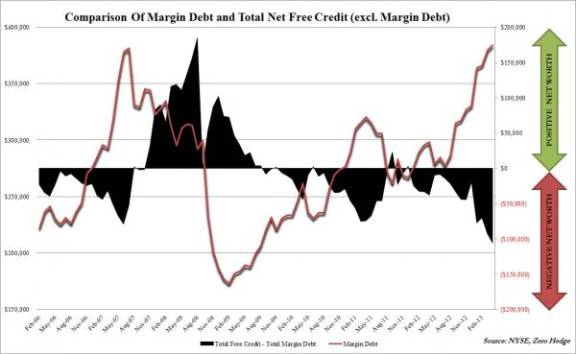
As
history proved two summers ago, when high-speed trading platforms pull back
from stocks to protect their own capital, “long term” investors can be left holding
the bag.
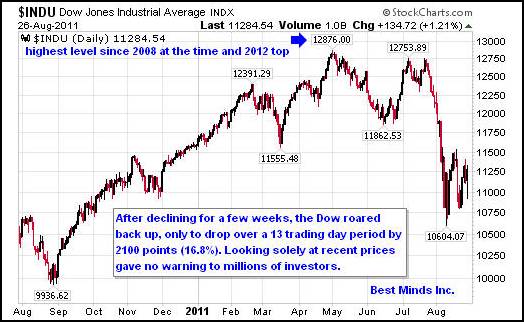
The
problem we have with a world driven by speed computers, is that eventually, the
computers are playing a game, looking for patterns. Whereas humans could have
evaluated economic and geopolitical news in order to PREPARE a portfolio for
rising risk, the computer - unless finding certain terms by which to react in
milliseconds to “the news” by means of artificial intelligence – is solely
focused on finding the pattern and beating its next slowest competitor in the
DAILY scalping game of hyper trading. As long as the rhetoric from central
bankers matches the view of “we have overcome risk and will always bring your
401k statement right back up”, the public at large will remain ignorant and
complacent. However, the reality is
that millions of investors have placed their futures next to a small group who
have left them holding the bag before when markets roll over from extremely
leveraged levels.
Yes,
the world of investing has changed radically.
“In 1933, the number of specialist firm on the NYSE
totaled 230. By 1983, acquisitions and mergers had reduced that number to 59.
By 2001, there were only 10. Today, only four DMMs (Designated Market Maker)
control the trading on the NYSE: Goldman Sachs, Knight, Barclays, and newcomer
GETCO….Most industry professionals we talk to believe these four horsemen are
responsible for 40-50% of all trading on the NYSE. “[Broken
Markets: How High Frequency Trading and Predatory Practices on Wall Street are
Destroying Investor Confidence and Your Portfolio (2012) Sal
Arnuk and Joe Saluzzi, location 621 of 5286 in the Kindle Edition]
Lesson 2 – Is Predictable a Good Thing?
If
you wanted the public to believe that they were watching an economic recovery,
what better way to do it than to have the Dow rise over a long period of time,
totally ignoring negative economic and geopolitical events? If you had the
power to turn markets at certain junctures, then the other smaller computers
and investment fish would eventually see bad news as good news, and buying the
dip would become a “sure thing”. If you think this would be impossible to
accomplish in a market as complex and diverse as the U.S. equity markets, take a
look at the charts below. This is not speculating on what WILL happen; it is
already a piece of history.
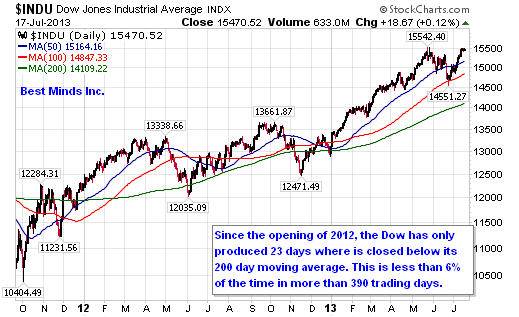
Once
the Dow broke above the 200 day moving average in December 2012, it has only
briefly stalled below this level. Did the high-speed trading platforms have
anything to do with this? Could they have helped “lead” the “recovery”?
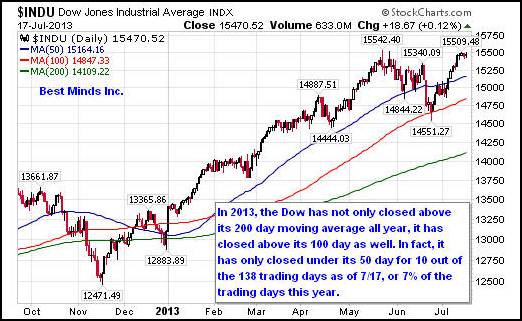
Now
move forward to 2013. Notice, that once
it was determined that the 200 day MA would hold at the end of 2012, and the
fiscal cliff was a joke – I mean, who ever said we had to have a debt ceiling
again anyway or record
the amount of national debt we were accumulating. The bounce level was
going to be at the 50 or 100 day moving averages, and beyond that, what is
there to know?


Now
think with me. Does history reveal that financial and political leaders desire
the public to be pleased with their progress, when they had little to do with
the progress that was made? Is it possible that the “progress” that has been
made, required loading the system with more and more debt and interfering with
markets to avoid those same markets from producing fear, while on the other
hand rewarding complacency? Does that sound like a free market?
While
the world of investors is still in the nirvana phase, is there anything one can
gain from examining the historical archives? Do you remember a recent period in
market history where SELLING rather than BUYING took place when these same
moving averages were hit?
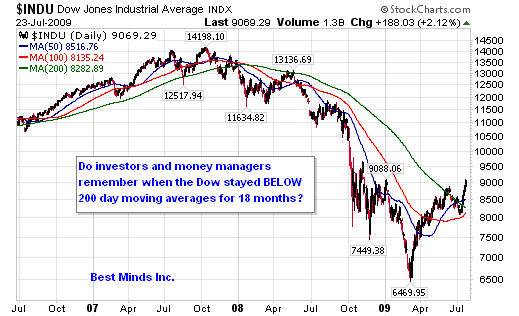
Lesson 3 – The Faster the Speed, the MORE likely an Accident
We
gain confidence the more we see something working. We lose confidence the more
we see something not working. And yet, this is exactly how great speculative
bubbles are formed. Instead of seeing rising risk as a caution to sell and pare
down, we see the rising prices as a lost opportunity and eventually succumb to
watching individuals purchasing stocks and funds at their highest prices on
record. We saw this in the spring of
2000, the fall of 2007, and are watching in live right now in the summer of
2013.
The
best way to watch the math reveal a trap and not a triumph, we need to look for
a pattern where markets climb faster with each subsequent rise, and declines
become more shallow. Whether we return to the March 2009 bottom – the lowest
this century – or the October 2011, we can see this pattern has already
unfolded quiet clearly.
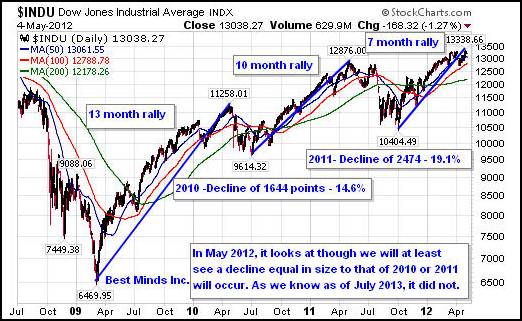
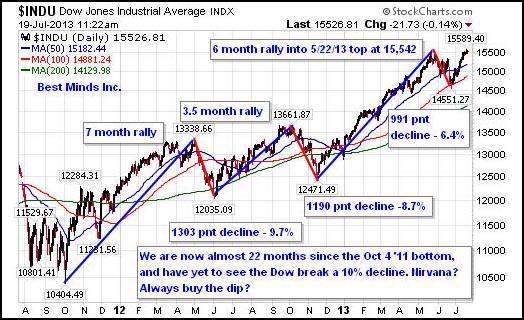
Looking
at the two charts above, we can see the following:
·
Rally of 13 months;
decline of 14.6% into 2010 low.
·
Rally of 10 months;
decline of 19. 1% into 2011 low.
·
Rally of almost 22
months, no decline beyond 10%.
Eventually,
the bounces become so predictable – both computers and individuals totally
ignoring all real world risk in order to capture the latest and hottest power
rally – we can see price levels achieve the larger gains in shorter periods of
time. The powerful drop that took place between June 19th and June
24th can only be seen in one way…another opportunity to get in, not a warning
sign of a major top.
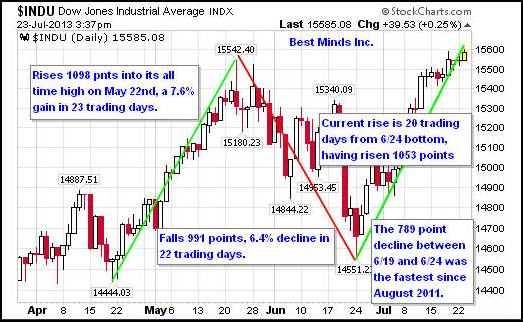
We
can see the same pattern in the larger Wilshire 5,000, the broadest US stock
index. Once the “fiscal cliff” was revealed as another stall in seriously
challenging the status quo on December 31, 2012, US stocks took off. The
Wilshire topped on February 19th. After a pull back to its 50-day
moving average, it took off again, topping on April 11th. Once again
it pulled backed to the 50 day MA, and started rising.
By
the time it reached its high on May 22nd, it had scaled 1622 points
in 23 trading days, averaging 84% more points than the climb into the April 11th
top. More points; shorter timeframe.
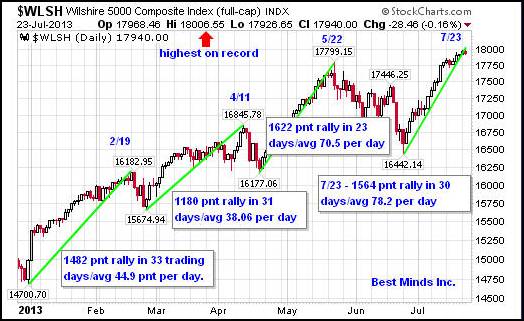
US
stocks had drifted sideways into the June FOMC meeting. When the Federal Open
Market Committee (FOMC), finished their regular scheduled meeting on June 19th,
their press release (2:00 EST) was not well received by investors or more
accurately, the split second artificial intelligence buried in the high frequency
computer trading programs. In less than 4 trading days, the Wilshire had shaved
off $1 trillion in paper wealth.
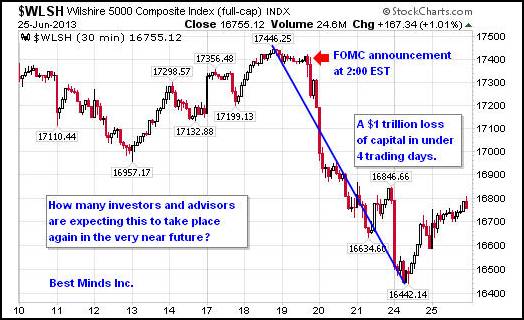
After
touching its 100-day moving average, the Wilshire 5000 started up again. As of
the close of business on Tuesday, July 23rd, the Wilshire has
reached 18,000 for the first time in the history of American markets. Its climb
between the June 24th low and this price level has taken 20 trading
days, thus producing a daily average price increase faster than its previous
run into its May 22nd high.
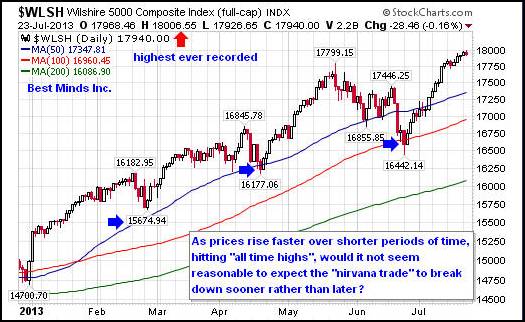
2000
and 2013 – Both are Warning US Stock Investors Now
In
case this still appears purely academic, let’s look at four more charts; two of
the NASDAQ 100 - one in March 2000 and the other three years later - and two
different views of the Dow Jones Corporate Bond Index, which on May 3, 2013,
reached its highest level on record.
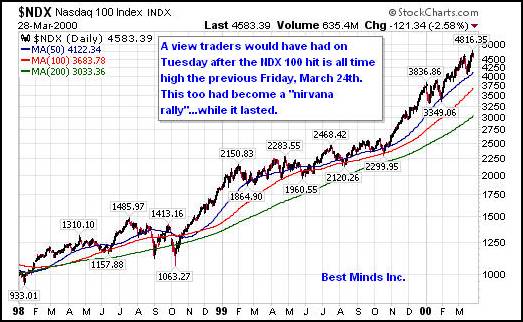
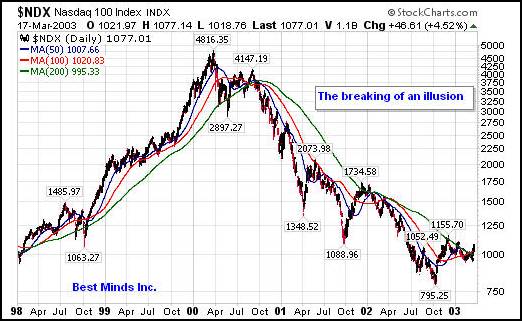
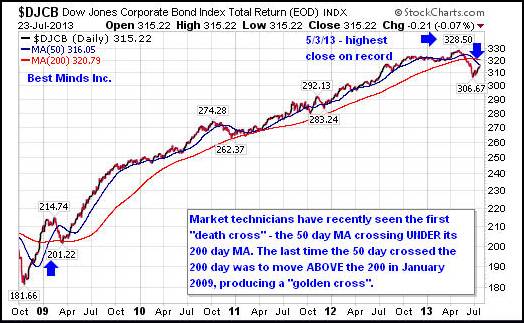

Even
material written 18 months ago by bankers outside of Wall Street, supports the
fact that the REAL world of finance has not been signaling a nirvana trade for
some time now.
“We currently live in a world of extraordinary
levels of government intervention and manipulation of the global market
economy. Tax credits, credit facilities, foreign currency interventions and
‘voluntary haircuts’ on foreign bonds are government attempts to postpone
inevitable market corrections.” Economic Uncertainty, Texas Banking,
January 2012, pg 9
May
we all remember, when everyone is doing the same trade, then it is time to look
in a different direction. The great trades made by contrarians were never from
following the crowd.
If you are ready to awaken
from the “trust the state, they will save us” theme, come join us. I have and
continue to look for some of the best thinkers around in this extremely deceptive
game in order to keep my own sanity and yours.
If you are challenging your own thinking, and are seeking ideas that are outside those presented by our illustrious central planners, then I would encourage you to subscribe to my most comprehensive research and trading commentary with a 6 month subscription to The Investor's Mind: Anticipating Trends through the Lens of History. Using the logical side of our brains, rather than enjoying the emotional comfort of unlimited mania, has never been more crucial in our markets.
Specific individual and institutional consulting is also available. If you are interested in learning more, send a personal note in an email to info@bestmindsinc.com and place “After 14” in the subject box. Emails with attachments and links will be deleted.
Seven years after its
release, I still refer back to my research paper Riders
on the Storm: Short Selling in Contrary Winds (Jan ’06). I would
encourage you to click
here to download it for free.
Doug Wakefield
President
HUBest Minds Inc.UH, a Registered Investment Advisor
2548 Lillian Miller
Parkway
Suite 110
Denton, Texas 76210
Phone - (940) 591 - 3000
Alt - (800) 488 - 2084
Fax - (940) 591 –3006
Best Minds, Inc is a registered investment advisor that looks to
the best minds in the world of finance and economics to seek a direction for
our clients. To be a true advocate to our clients, we have found it necessary
to go well beyond the norms in financial planning today. We are avid readers.
In our study of the markets, we research general history, financial and
economic history, fundamental and technical analysis, and mass and individual
psychology.